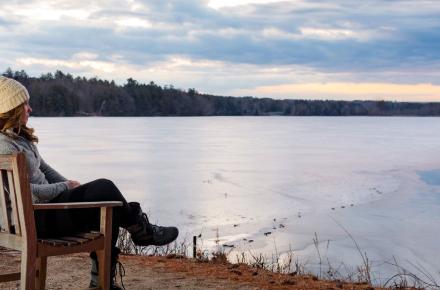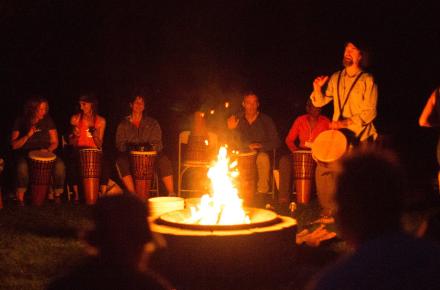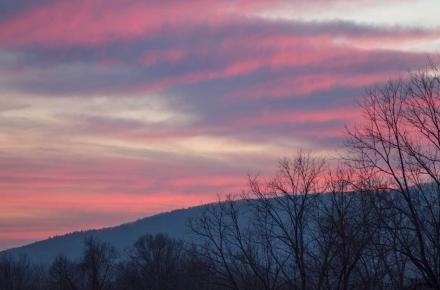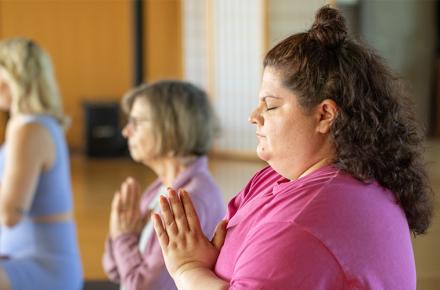The Yogic Road Map to Self-Discovery: A Q&A with Yoganand Michael Carroll
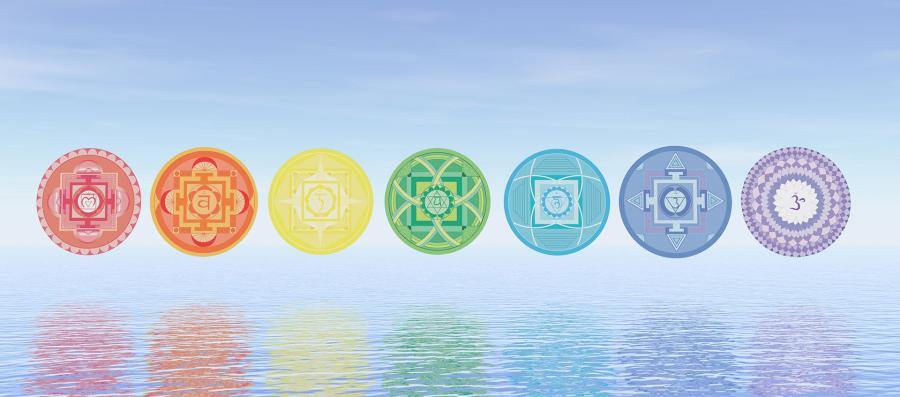
Yoganand Michael Carroll, Senior Faculty of the Kripalu School of Yoga, is known for his ability to distill and interpret esoteric yoga texts and techniques. In this Q&A, he explains the origins of the concepts of chakras, granthis, and nadis—symbols that ancient yogis developed to map the journey inward.
Are most yoga teachers familiar with the chakras and nadis?
Most teachers have studied the chakras and some are familiar with the nadis, but often just as catchphrase and sound bites. They don’t know where they came from and how they fit into a modern practice. You might hear the instruction in a yoga class, “Open your heart chakra,” but what does that really mean? I recently taught a workshop on yogic symbolism where I asked people to share the strangest thing they had been told about their chakras, and one student said a teacher had told her that her chakras were spinning backwards!
How do you explain the chakras metaphorically?
While modern psychology gives us a language to understand mental and emotional processes, the ancient yogis had to develop their own terminology to explain their observations and the effects of their practices, and they drew heavily on metaphors from their daily life. Much of India in their time was made up of small villages and towns surrounded by dense jungle, which contained many unknown dangers—and possibly great treasures. The yogis saw consciousness as a village surrounded by jungle, and the process of self-discovery was to explore that jungle. To explore the jungle around the villages, they needed to build roads into it, and they built waystations called chakras—fortresses where travelers could take refuge, which often contained temples to gods and goddesses who could offer spiritual protection. In the process of inner exploration, these roads were called nadis, and the fortresses, or chakras, were built on the very edges of consciousness, the boundaries between the rational self and the vast unconsciousness, where inner work could be done before the next exploration into the jungle. The seeker had to befriend the “gods and goddesses” of these fortresses to receive their protection and guidance—today we might call them by names such as discrimination, abundance, truth, or compassion—to find protection from the “monsters” of fear, selfishness, and greed encountered on the path.
What about the granthis? What are they, and how do they fit into this metaphor?
Some ancient yogis would go out into the jungle or forest on a moonless night, spread out their mats, and meditate there all night. It was a way to practice witnessing and releasing fear. Eventually this process moved inward, so it wasn’t about the lions in the jungle anymore, but rather the fear, obsession, and desire that create inner disturbances. These are the granthis, the knots where spirit and matter become entangled. Yoga teaches that there are a number of places in the body, called adharas, where these knots are likely to be found. The yogi moves the attention through the body, focusing for periods of time on the different adhara points; some are neutral and others are more charged. Neutral and charged points will vary from one person to another. When an emotional reaction occurs at a point, a granthi has been discovered. Through the process of witnessing the reaction, the granthi is untangled and the charge is released.
Granthis are sources of pain, and are created when we resist dualities. In the oldest models, a granthi forms when we confuse the permanent with the ephemeral, treating the ephemeral as if it were permanent. Granthis can form between fantasy and reality, when we want something to be real that isn’t. Granthis can manifest through a resistance or a push-and-pull between forces—for example, between apana, the psycho-spiritual force that pulls our attention outward, and prana, which pulls our attention inward; or between raja guna, the force of momentum, and tamas guna, the force of inertia. While tantra yoga looks for granthis in the psyche, hatha yoga finds them in the physical body. In their psychological representations, granthis can continually change shape and form, but if you can locate them in the body, they are much less mobile and it’s easier to get to their roots.
Kripalu Yoga has always been a yoga of self-discovery and self-healing—Swami Kripalu believed that yoga postures and pranayama were designed to activate the granthis, so practitioners could work toward unraveling the knots. The bandhas, mudras, kriyas, pratyaharas, and dharunas are all practices designed to address the granthis.
In Kripalu School of Yoga trainings, how do you create safety for teachers to do these deeper practices of self-exploration?
It’s important to create a balance between how much we’re in our bodies and how much we’re in our heads. I give people enough practice time so they can experience some of what we’re talking about, and then we look at what happened to them during the practice. Swam Kripalu said that, for every hour of meditation, you need four to five hours of contemplation to digest it. If the practice leaves you feeling disoriented or expanded, what do you do with this? We work with it in a way that doesn’t take you out of the experience but instead gives new meaning to the experience, by observing it through the lens of yoga rather than the lens of psychology. Teachers already have the language of psychology and personal growth, so the yogic model gives them another tool for working with self-exploration. It’s like using a road map versus a topographic map—it gets you to the same place, but the journey is different.
How can teachers take this work to their students?
This deep exploration is not something teachers will typically share in their classes at fitness centers or yoga studios, but it will change the way they teach. This understanding of traditional yoga will give them inspiration for themes, meditations, relaxations, and imagery that they can bring into their classes. I could walk into room and offer a purely physiological class—have students stretch their hamstrings, strengthen their quads, do some side-bending. Or I could teach the class from the perspective of prana and apana, looking at where the students’ attention is and having them close their eyes, breathe deeply, etc., in order to bring their focus inward. I might use exploring the forest as a theme, either as an internal guide for my teaching or as an image that I share with my students—observing the beautiful and scary things along the way, noticing that every scene as you move through the forest is different from the one before. When you have this road map, there are lots of different ways you can apply it.
Swami Kripalu taught that yoga’s purpose is to dissolve the self into universal oneness. I want teachers to understand that the yoga practices were originally made to do that, and give them the tools they need to make their inward journeys safe and effective, if they choose to follow this path. They are the ones who will take yoga into the future, and I want them to understand what yoga was and how it’s evolved, so they can influence it going forward.
Find out about upcoming programs with Yoganand Michael Carroll at Kripalu.
© Kripalu Center for Yoga & Health. All rights reserved. To request permission to reprint, please email editor@kripalu.org.





























